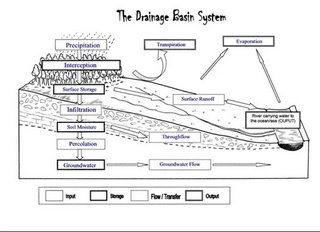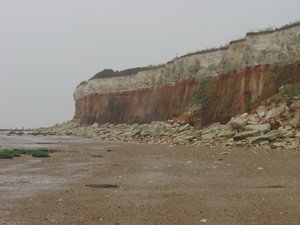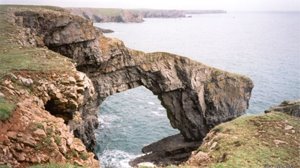LYNMOUTH FLOOD 1952 (Devon)
The Lynmouth Flood
It happened in August of 1952,
The size of the river suddenly grew;
It tossed and turned and ruined lives,
It killed husbands, children and wives;
The sun disappeared, they sky turned grey;
This was no longer an ordinary day.
The water rose to 40ft high,
You could here all around the people cry.
In the months before there had been lots of rain,
The ground no longer became a drain.
The ground trembled, water came crashing,
Parents were runnning, children were splashing;
When the water came in there was no place to, hide
The river was loud, fast and wide;
It came thundering in and over took the land,
Destroying houses like a giant's hand. (Chloe - Yr 8)

The flood which hit the Devon village of Lynmouth on August 15th 1952 was one of the worst in living memory in Britain. This
BBC article from the time gives an introduction to the disaster. Floods the size of that which struck Lynmouth may occur only every 100 - 200 years. For your exam you will need to know the causes of the floods and the effects on the people, environment and economy of Lynmouth.
CAUSES OF THE LYNMOUTH FLOOD

So what did cause the River Lyn following through Lynmouth to burst its banks in such a devasting way in August 1952? The answer to this question involves consideration of several contributing factors which had increased the likelihood of such a flood taking place (click on diagram for a summary of the factors).
- The small but steep sided drainage basin in which Lynmouth was situated increased the risk of flooding in the area. The steep sides encouraged greater surface runoff and combined with the small drainage basin size meant any water could reach the river fairly quickly;
- This was made worse by the high drainage density of the area due to the impermeable rocks of the area around Exmoor which formed the source of the river; again increasing the amount of surface runoff following rainfall;
- Prior to August 15th 1952 Lynmouth had received above average rainfall for 12 out of the first 14 days of the month meaning the soils were already saturated and the river levels high.
- On August 15th a heavy thunderstorm resulted in 200mm falling in 14 hours, one of the three heaviest rainfalls recorded in the UK. This heavy rain combined with the saturated ground and rapid surface runoff resulted in a huge volume of water flowing down the river. As Lynmouth is situated at the confluence of the East and West Lyn rivers the volume of water was increased further at this point and the was far beyond the capacity of the river channel causing the river to burst its banks. This resulted in devastating floods as the West Lyn which had been diverted during the construction of parts of Lynmouth retook its natural course, flowing straight through the village.
EFFECTS OF THE LYNMOUTH FLOOD
You will need to make sure you learn place specific facts about both causes and effects in order to achieve the full marks in case study questions - here are a list of some of the effects of the Lynmouth Flood:
- Debris built up behind bridges resulting in the build up of a flow of water which eventually burst resulting in torrents of water flowing through Lynmouth with 34 people being killed in the disaster
- The West Lyn river took its original course flowing straight through Lynmouth destroying 90 houses and hotels;
- 130 cars and 19 boats were also lost, swept into the river or out to sea as the force of water was able to transport large amounts of debris (including gigantic boulders)
- Debris transported by the River Lyn resulted in the enlargement of the River Delta
This
link to audio clips features interviews with some survivors of the Lynmouth Flood
Flood Management
Following the Lynmouth flood disaster, flood management plans were put in place to try and ensure such a disaster could not happen again by managing any excess rain water so that the River could cope in the future.
A number of flood management strategies were put in place:- The mouth of the East Lyn was widened to increase capacity and allow water to quickly pass into the Bristol Channel
 The West Lyn was straightened to increase channel efficiency - straightening the channel reduces friction and increases velocity, enabling water to travel through the channel as quickly as possible making it more efficient in coping with flood waters;
The West Lyn was straightened to increase channel efficiency - straightening the channel reduces friction and increases velocity, enabling water to travel through the channel as quickly as possible making it more efficient in coping with flood waters;- The West Lyn was not rediverted, instead being allowed to follow its natural course
- Floodplain zoning was used to identify areas around the river most at risk from flooding. Building restrictions were then put in place with areas close to the river which are most prone to flooding being left as open spaces such as car parks.
- Bridges were made wider and taller to allow flood water to tr avel quickly beneath them and to reduce the likelihood of debris becoming trapped and acting like a dam as had happened in 1952;
- Embankments were built by the river to increase channel capacity and reduce the likelihood of flooding;
- More trees were planted upstream in the source area to try and reduce initial surface runoff through interception and the soaking up of water. Tree roots also help to improve infiltration by opening up the soil and slowing down the rate at which water reaches the ground;
Follow up links:The following links provides further useful background on the Lynmouth Flood
Lynmouth Flood of 1952Exmoor National Park - the Lynmouth Flood2002 Memorial for the Lynmouth DisasterRain Making link to killer floods - an interesting twist in the tale which some people have said could explain the higher than usual levels of rainfall!
Source of Photographs www.geographyphotos.com / A Lawson















































